|
|
 |
|
Calanoida ( Order ) |
|
|
|
Clausocalanoidea ( Superfamily ) |
|
|
|
Euchaetidae ( Family ) |
|
|
|
Paraeuchaeta ( Genus ) |
|
|
| |
Paraeuchaeta exigua (Wolfenden, 1911) (F,M) | |
| | | | | | | Syn.: | Euchaeta exigua Wolfenden, 1911 (p.300, Descr.F, figs.F); Vervoort, 1957 (p.82, Rem.); Grice & Hulsemann, 1967 (p.15); Bradford, 1972 (p.40, figs.F, Rem.); Park, 1978 (p.235, figs.F,M, Rem.); Pareuchaeta exigua : C.B. Wilson, 1950 (p.280, figs.F) | | | | Ref.: | | | Bradford & al., 1983 (p.39, figs.F,M, Rem.); Razouls, 1994 (p.93, figs.F, M); Park, 1994 (p.321); 1995 (p.77, Rem.F,M, figs.F,M); Bradford-Grieve & al., 1999 (p.880, 926, figs.F,M) | 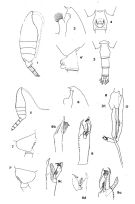 Female: 1, habitus (lateral); issued from : Bradford, Haakonssen and Jillett in Mem. N.Z. oceanogr. Inst., 1983, 90: 1-150. 2, Head (lateral); 3, Urosome (dorsal); 4, 4', genital segment (ventral, lateral); issued from : Park T.-S. in Antarct. Res. Ser. Washington, 1978, 27: 91-290. Male: 5, habitus (lateral); issued from : Bradford & al., 1983. 6, Head (lateral); 7, 7', Th5 (lateral); 8, P5 (G: left, Dt: right); 9, 9a, distal exopodite of P5; issued from : Park, 1978; 9b,c,d, distal exopodite of P5; issued from : Bradford & al., 1983.
|
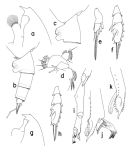 issued from : T. Park in Bull. Scripps Inst. Oceanogr. Univ. California, San Diego, 1995, 29. [p.184, Fig.74]. Female: a, forehead (left side); b, urosome (left); c, genital somite (left); d, Mx1 (first inner lobe omitted), posterior; e, exopod of P1 (anterior); f, exopod of P2 (anterior). Nota: Cephalosomal appendages as in P. norvegica except that basis of Mx1 with 4 setae, small outermost seta being absent as in P. tonsa. Outer spine of 1st exopodal segment of P1 very small. 2nd outer spine of 3rd exopodal segment of P2 reaching close to base of following outer spine, and about as long as outer spine of 2nd exopodal segment; incision separating 2nd marginal lobe of 3rd exopodal segment relatively deep, reaching about 3/5 way from distal to proximal end of segment, while in P. norvegica, it reaches about halfway from distal to proximal end of segment. Male: g, forehead (left); h, exopod of P2 (anterior); i, exopod of left 5th leg (medial); j, distal endof left 5th leg exopod (anterior, tilted counterclockwise); k, serrated lamella and digitiform process of left 5th leg exopod (anterior, tilted clockwise).
|
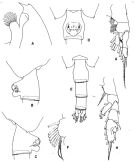 issued from : T. Park in Antarctic Res. Ser. Washington, 1978, 27. [p.236, Fig. 88]; As Euchaeta exigua. Female: A, forehead (lateral); B, C, D, distal end of metasome and genital segment (left side, right side, and ventral, respectively); E, posterior part of metasome and urosome (dorsal); F, outer lobe of Mx1; G, P1; H, P2. P1-2: legs (anterior).
|
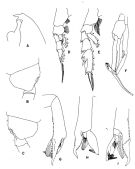 issued from : T. Park in Antarctic Res. Ser. Washington, 1978, 27. [p.237, Fig. 89]; As Euchaeta exigua. Male: A, forehead (lateral); B, C, last metasomal and genital segments (left side and right side, respectively); D, P1; E, P2; F, P5; G, H, I, distal part of exopod of left P5 (anterior, lateral, and medial, respectively). P1-5: legs (anterior).
|
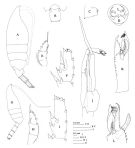 issued from : J.M. Bradford, L. Haakonssen & J.B. Jillett in Mem. N.Z. Oceanogr. Inst., 1983, 90. [p.40, Fig.19]. Female: A, habitus (lateral right side); B, genital segment (dorsal); C, idem (lateral right side); D, genital field (ventral); E, exopod of P1; F, exopod segment 3 of P2. Nota: - P1 exopod female: Aa = 1/3 AB; Bb = 4/5 BC; Cc ± BC. - P2 exopod female: Aa ≥ AB; Bb = 1/2 BC; Cc = 5/6 CD; Dd = 1/4 CD. (see code of lengths outer spines in the Genus' figure, or in Paraeuchaeta sp. A). Male: G, habitus (lateral right side); H, exopod of P1; I, exopod segment 3 of P2; J, P5; K, medial view of terminal part of left P5 exopod; L, terminal part of left P5 exopod. Nota: The present males vary in the length of the left P5 exopod segment 3 relative to the serrated lamella, which may be slightly longer or shorter. P1 exopod male: Aa minute; Bb = 1/3 BC; Cc = 1/2 BC. - P2 exopod male: Aa = 1/3 AB; Bb = 1/2 BC; Cc > 1/3 CD; Dd = 1/4 CD. (see code of lengths outer spines in the Genus' figure, or in Paraeuchaeta sp. A).
|
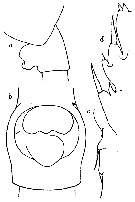 issued from : R.N. Wolfenden in Die Marinen Copepoden der Deutschen Südpolar-Expedition 1901-1903, 1911. [p.300, Fig.52]. As Euchaeta exigua. Female: a, posterior part cephalothorax and genital segment; b, genital segment (ventral); c, outer margin of exopod of P1; d, outer margin of exopod of P2.
|
 issued from : J.M. Bradford in Mem. N. Z. Oceonogr. Inst., 1972, 54. [p.41, Fig.8, (14-16)]. As Euchaeta exigua. Female (from Kaikoura, New Zealand): 14, habitus (dorssal); 15, exopod segment 3 of P2; 16, genital segment (lateral, left side). Scale bars: 1 mm (14, 15, 16). Nota: This specimen agrees with the description of Wolfenden, except that its abdomen is very hairy.
|
 Paraeuchaeta exigua Paraeuchaeta exigua Female: 1 - See key to species Groups and independent species of Paraeuchaeta (p.30). 2 - Laterally, genital field facing ventrad, with large tubercular outgrowth behind genital orifice (Fig.74-c). 3 - Genital somite without transverse ridge on ventral side anterior to genital prominence (Fig.74-c). 4 - Laterally, genital flange low and inconspicuous (Fig.74-c). 5 - Laterally, genital prominence relatively low (Fig.74-c)
|
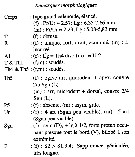 Issued from : C. Razouls in Ann. Inst. océanogr., Paris, 1994, 70 (1). [p.93]. Caractéristiques morphologiques de Paraeuchaeta exigua femelle et mâle adultes. Terminologie et abbréviations: voir à Calanus propinquus. Nota: La femelle ressemble à celle de P. pseudotonsa (Fontaine, 1967).
| | | | | Compl. Ref.: | | | Sewell, 1948 (p.523); De Decker & Mombeck, 1964 (p.13); Errhif & al., 1997 (p.422); Razouls & al., 2000 (p.343, Appendix); Park & Ferrari, 2009 (p.143, Table 5, Appendix 1, biogeography); Takahashi & al., 2010 (p.1, Table 4); Takahashi & al., 2011 (p.134, distribution); | | | | NZ: | 5 | | |
|
Distribution map of Paraeuchaeta exigua by geographical zones
|
| | | | | | | | | 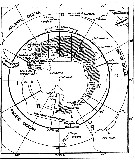 issued from : W. Vervoort in B.A.N.Z. Antarctic Reseach Expedition, Reports - Ser. B, Vol. III, 1957 [Fig.68]. As Euchaeta exigua. issued from : W. Vervoort in B.A.N.Z. Antarctic Reseach Expedition, Reports - Ser. B, Vol. III, 1957 [Fig.68]. As Euchaeta exigua.
Chart showing the geographical distribution (white triangle) in the seas surrounding the Antarctic continent.
Nota: In this chart the area frequented by whaling vessels has been hatched. The Antarctic circle (66°.5 S) has been drawn as a broken line. The numbers I to VI refer to the sectors into which the Antarctic seas are divided according to Mackintosh (1942) (after Vervoort, 1951). |
| | | | Loc: | | | Antarct. (Weddell Sea, Indian), sub-Antarct. (Indian), South Africa (E), off E Tristan da Cunha, W Indien, S Indian (subtropical convergence), S New Caledonia, S Australia, S Tasmania, Tasman Sea, New Zealand (Kaikoura), NE Easter Is. (in C.B. Wilson, 1950) | | | | N: | 12 | | | | Lg.: | | | (3) F: 7,3-6,4; M: 6-5,3; (9) F: 7,6-6,1; M: 5,4-4,7; (10) F: 6,7; (20) F: 7,66-6,35; M: 5,83-5,08; (25) F: 6,75; (116) F: 6,95; {F: 6,10-7,66; M: 5,08-6,00} | | | | Rem.: | Meso-bathypelagic.
Sampling depth (Antarct., sub-Antarct.) : 0-3000 m.
For Park (1995, p.78) the female of this species can be readily diagnosed by its characteristic genital soite. The male is so close morphologically to those of the other species of the Group that its identification requires careful examination of certain characters. The most useful are the flat anterior margin of the rostrum, a single conical process on the posterior margin od the 1st exopodal segment of the left P5, the elongate, spiniform distal process of the serrated lamella of the left P5.
Park (1995) found the species in the eastern and western regions of the South Atlantic between 30°S and 36°S, south of New Caledonia and the Tasman Sea between 25°S and 50°S, and the western Indian Ocean between 25°S and 35°S. According to these and previous records, this species seems to be restricted in distribution to four isolated areas. | | | Last update : 07/12/2020 | |
|
|
 Any use of this site for a publication will be mentioned with the following reference : Any use of this site for a publication will be mentioned with the following reference :
Razouls C., Desreumaux N., Kouwenberg J. and de Bovée F., 2005-2025. - Biodiversity of Marine Planktonic Copepods (morphology, geographical distribution and biological data). Sorbonne University, CNRS. Available at http://copepodes.obs-banyuls.fr/en [Accessed January 02, 2026] © copyright 2005-2025 Sorbonne University, CNRS
|
|
 |
 |












